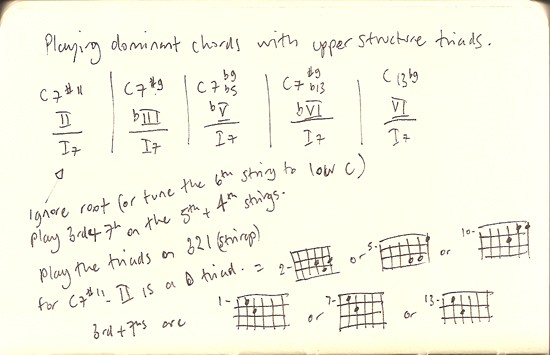Three part chords is what we have here.
Part 1. The Bass Note
It’s a C. Leave it to the bass player – they’ve trained their whole entire lives to play a nice low note, so don’t be trying to get in on the act. Let the bass be the bass. Or tune the 6th string all the way down to C. Sod ’em.
Part 2. The Third and Seventh
As these are all dominant chords we need the 3 and b7, so that’s E and Bb. These notes are played on the 5th and 4th strings, which means that there’s only a couple of places to play them.
Part 3. An Upper-Structure Triad
For these chords, we’re using major triads on the top three strings.
All Together
Mixing all that together gives us a way of playing dominant chords.
If you play the piano it’s very simple to see:
- Left hand plays the 3rd and 7th
- Right hand plays a major triad
On the guitar you might have to twist your fingers around for some of the shapes. But that’s what you signed up for. Ha ha ha.
What else? Well if you know some voicings that don’t have the root at the bottom, you’ll be in the top 0.005% of guitarists who can do that.
And the bass player will brush your hair and call you Barbie.
And you will call him Ken.

You need to try:
UST Jazz Piano Chord Voicings. Vol 1. to 9
All possible USTs over IIm7 and V7 are found and explore there. You also have a log to write your perception of each UST and keep track of the ones you’ve tried and liked.
Ow, you made my brain hurt :)
I really like this approach, and the sound is nice because you get this consonant triad at the top with the tri-tone crunch at the bottom. I also find the C7(#11) and C7(#9b13) shapes reinforce the way I see Lydian +5 voicings… So instead of seeing C7(#11) as Bbmaj7+5, you can see it as a D triad (II of C7) with a b13, so basically in relation to the Mixo b13 mode.
Anyway…cheers for the post Mike, really interesting!